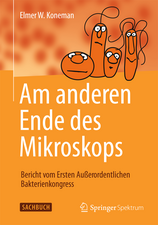Antibiotics: An Integrated View: Springer Series in Microbiology
Autor Giancarlo Lancini Traducere de Betty Rubin Autor Francesco Parentien Limba Engleză Paperback – 9 noi 2011
Preț: 386.81 lei
Nou
Puncte Express: 580
Preț estimativ în valută:
74.04€ • 80.45$ • 62.23£
74.04€ • 80.45$ • 62.23£
Carte tipărită la comandă
Livrare economică 21 aprilie-05 mai
Preluare comenzi: 021 569.72.76
Specificații
ISBN-13: 9781461256762
ISBN-10: 1461256763
Pagini: 272
Ilustrații: XII, 253 p. 14 illus.
Dimensiuni: 155 x 235 x 14 mm
Greutate: 0.39 kg
Ediția:Softcover reprint of the original 1st ed. 1982
Editura: Springer
Colecția Springer
Seria Springer Series in Microbiology
Locul publicării:New York, NY, United States
ISBN-10: 1461256763
Pagini: 272
Ilustrații: XII, 253 p. 14 illus.
Dimensiuni: 155 x 235 x 14 mm
Greutate: 0.39 kg
Ediția:Softcover reprint of the original 1st ed. 1982
Editura: Springer
Colecția Springer
Seria Springer Series in Microbiology
Locul publicării:New York, NY, United States
Public țintă
ResearchCuprins
1 The Antibiotics: An Overview.- I. Definition.- II. Chemical Nature.- III. Producing Microorganisms.- IV. Biosynthesis.- V. Activity and Resistance.- VI. Mechanism of Action.- VII. Chemotherapy.- VIII. Chemical Modifications.- IX. Principal Classes of Antibiotics.- 2 Activity of the Antibiotics.- I. Definition.- II. Determination of the Minimal Inhibitory Concentration in Liquid Medium.- III. Determination of the Minimal Inhibitory Concentration in Solid Medium.- IV. Determination of Antibiotic Activity by the Agar Diffusion Test.- V. Factors Affecting the Determination of Antibiotic Activity.- VI. Determination of the Minimal Bactericidal Concentration.- VII. The Antibiogram (Bacterial Sensitivity Test).- VIII. Spectrum of Antibiotic Activity.- IX. Interaction of Antibiotics.- X. Recent Microbiological Techniques: Miniaturization and Automation.- 3 Mechanism of Action of the Antibiotics.- I. Relationship Between the Mechanism of Action and the Selectivity of the Antibiotics.- II. Methods for Study of the Mechanism of Action of Antibiotics.- III. Inhibitors of Cell Wall Synthesis.- IV. Inhibitors of Transcription and Replication of Genetic Material.- V. Inhibitors of Protein Synthesis.- VI. Inhibitors of Cell Membrane Functions.- VII. The Antimetabolites.- 4 Resistance of Microorganisms to Antibiotics.- I. General Aspects.- II. Biochemical Bases of Resistance.- III. Genetic Aspects.- 5 Activities of the Antibiotics in Relation to Their Structures.- I. Introduction.- II. ?-Lactam Antibiotics.- III. Tetracyclines.- TV. Aminoglycosides.- V. Macrolides.- VI. Ansamycins.- VII. Peptide Antibiotics.- VIII. Miscellaneous Antibiotics.- 6 Biosynthesis of Antibiotics.- I. Primary and Secondary Metabolites.- II. Methods of Study.- III. Antibiotics Derived from a Single PrimaryMetabolite.- IV. Antibiotics Derived by Condensation of Several Metabolites.- V. Antibiotics Derived by Oligomer or Polymer Formation.- 7 Search for and Development of New Antibiotics.- I. Search for New Antibiotics.- II. Development of an Antibiotic from the Laboratory to the Clinic.- III. Development: From the Laboratory to the Manufacturing Process.- 8 The Use of Antibiotics.- I. Chemotherapy of Infectious Diseases.- II. Uses Other than Human Pharmacology.- III. Antibiotics as Research Tools.- 9 Antibiotics and Producer Organisms.- I. Classes of Antibiotics and Taxonomic Positions of Producing Organisms.- II. Paradox: How to Avoid Suicide.- III. Hypotheses about the Function(s) of Antibiotics in Producing Organisms.- Further Readings.




















